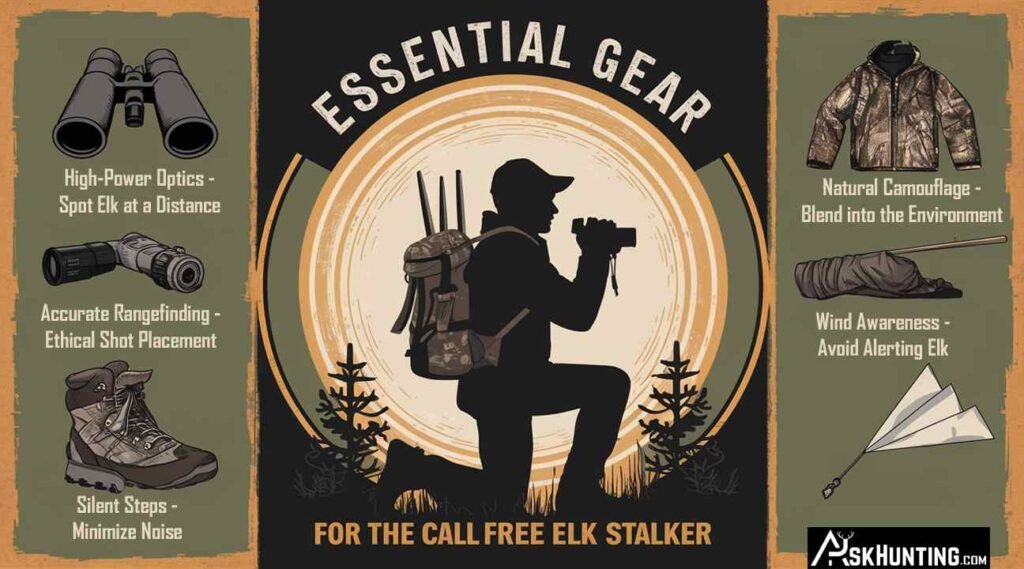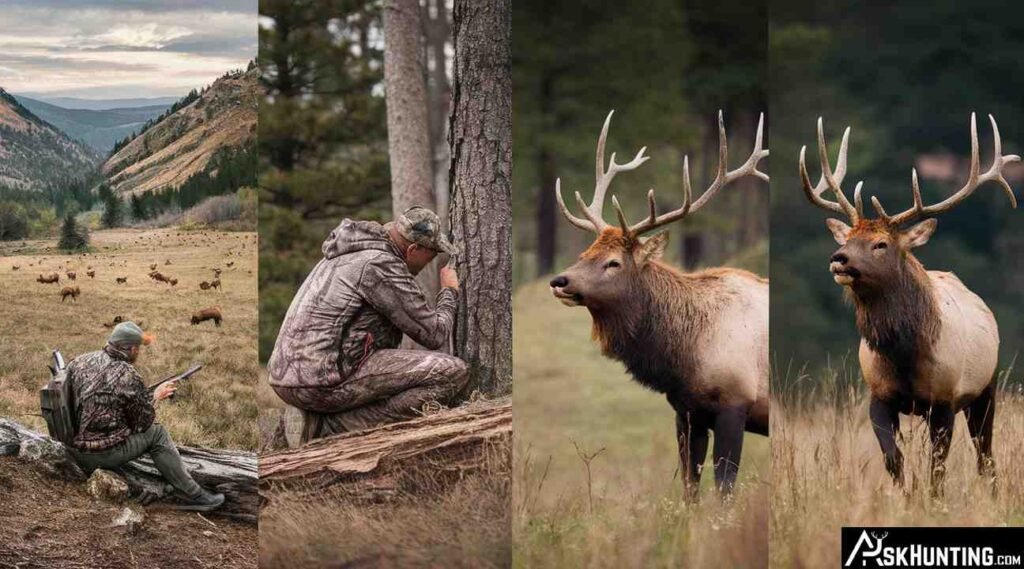There’s no doubt that bagging an elk brings a surge of victory. Now, imagine reaching that high without using calls? Hunting elk sans calls, though tough, can indeed be fulfilling. It assesses your ability to stay composed, strategize well, and comprehends the elk’s patterns. Let’s explore crucial tips and techniques you can use to cleverly beat these conscious animals in their home ground.
Understanding Elk Behavior: When to Skip the Calls
You often use calling when hunting elk, yet it may not always be the top strategy. Let’s look at when not calling and instead choosing to stalk could be the smart move:
- Busy Hunting Grounds: In zones where hunting is rampant, elks tend to ignore calls more. The heightened levels of alertness make them less responsive to calls, and overly energetic calling can scare them off.
- Revealing Landscapes: Bare meadows or thinly spread woodlands provide limited natural concealment, which keeps elk on their toes. Using calls in such settings might uncover your location, making the it dash away.
- Targeting Specific: Mature, prize-worthy elks are usually more wary than their younger counterparts. They’re not easily enticed by calls, and maintaining silence helps you approach them stealthily for a better shot.
Common Elk Vocalizations and Meanings
| Vocalization | Description | Hunter Interpretation |
|---|---|---|
| Bugle | A bull’s call is a deep, extended sound. It’s frequently heard, especially from older bulls. During mating season, it’s used to show power and draw in partners. | Could suggest a grown bull is nearby. Be careful, calling out might frighten him. |
| Cow Call | High-pitched, wavering call. Used by cows to communicate with each other and their calves. | Possibly points to a group of cow elk. Hunters might mimic a lone calf to attract bulls during mating season. |
| Bark | Brief, loud sound. Cows or their young use it often to signal threats. | Shows that elk sense something out of the ordinary and could run off. Be careful and make sure to stay unseen. |
| Meep | A gentle, shrill noise. Young cows use it to keep in touch with their mums. | This could suggest a group of female elk with their young ones present. |
Sure, calls are useful sometimes. But knowing when and how to use them can help you make a sound decision about when to swap the call for your sneaky talents.
Mastering the Art of the Silent Stalk
The bedrock of a great elk hunt—without using calls – is all about careful planning and nailing the skill of moving in silence.
Pre-Hunt Scouting:
- Identifying Patterns: Before the hunt, spend time observing. Watch the elk to see where they eat, sleep, and move. This helps plan your approach and guess their next moves.
- Analyzing Terrain: Look for places with lots of hiding spots, like thick woods with mixed landscapes or hilly areas with high plants. Be mindful of the usual wind direction. Keep on the side where the wind is blowing from to prevent the animal from noticing you by your smell.
Gear and Clothing for Stealth:
- Camouflage Selection: Select a camouflage that effortlessly merges with your hunting surroundings. Go for ordinary earth shades and designs that mimic the prevailing plants in your hunt spot.
- Quiet Footwear and Equipment: Each move matters. Choose top-notch, silent hunting boots that grip well. Stay clear of baggy clothes or noisy gear that might reveal where you’re hiding.
Utilizing the Elements for Cover:
- Moving During Low-Light Conditions: Make your move for the elk at sunrise or sunset when they’re bustling and sight is low. This lets you wander more loosely under the cover of nightfall.
- Using Natural Features: Make the most of natural structures such as crests, trenches, and plants to conceal your motion. Shift gently and purposefully, keeping as close to the earth as possible and reducing your presence.
Essential Gear for the Call-Free Elk Stalker

| Gear Item | Importance | Tips |
|---|---|---|
| Camouflage Clothing | Blends in with the environment | Opt for nature-inspired hues and designs that mirror the primary plant life in your hunting zone. Think about varying camouflage for differing landscapes (like open meadows compared to thick woodlands). |
| Quiet Boots | Minimizes noise while walking | Purchase good boots that fit well and have strong grip. Don’t have untied shoelaces or noisy gear that could expose your location. |
| Binoculars | Enhances observation | For spotting elk far away, pick powerful binoculars (8×42 or 10×42) that work well in dim light. |
| Rangefinder | Determines accurate distance to target | Important for deciding where to aim. Make sure the rangefinder aligns with your gun or bow. |
| Wind Indicator | Helps identify wind direction | Use a tiny, light flag or powder to see how the wind blows. This helps prevent scaring the elk by your smell. |
Advanced Stalking Techniques
Catching a cautious elk needs a sharp eye and a grasp of their communication signals.

Reading Body Language:
- Understanding the Gestures: Notice Alertness Signs: Look for signs of vigilance, like a lifted head, upright ears, and an attentive stare. These show that the elk might have detected something strange and could be ready to flee.
- Spotting Peaceful Behavior: Meanwhile, easy-going acts like nibbling grass or taking a break suggest a feeling of safety. This is the perfect moment to get nearer for a shot.
The Art of the Cloverleaf Maneuver:
- Repositioning for Advantage: When it knows you’re there, don’t back down. Apply the “cloverleaf technique” to move yourself unseen and downwind. This means walking around behind something big enough to hide you as you sneak back into a prime position.
- Stay Hidden While You Move: As you reposition, your top priority is to remain unseen. Make use of every hiding spot you find, even if it makes your journey longer. Patience is crucial – let the elk lower their guard before you plot your next action.
Patience and Persistence are Key:
- Waiting for the Right Opportunity: Success in stalking demands loads of patience. Ready yourself to commit to watching elk actions while waiting for the best shot.
- Adapt to Shifts: Stay flexible during the stalk. Be ready to tweak your method according to the elk’s steps, wind flow, and unexpected hurdles.
Ethical Considerations: Respecting the Animal
Hunting right is crucial. Here’s what considerate hunters think about:
- Knowing Your Boundaries: Make sure you’re in a safe shot distance. You need to be certain you can take a clean, quick kill. If not, the animal suffers—it’s a bad situation and a lost resource.
- Respecting the Animal: Prevent stress on the animal. Don’t use harsh tactics or long chases. Considerate hunters aim for a clean and honorable catch.
Tips for a Successful Call-Free Stalk: Sharpening Your Skills
Don’t just master the tech stuff of tracking. Paying attention to your mind and body can really pump up your chances of winning.
- Staying Fit is Key: Elk hunting isn’t a walk in the park. You have to navigate rough landscapes, travel far, and wiggle through thick bushes. It’s vital to boost your stamina with heart-pumping exercises and leg workouts. If you’re fit, you can keep a calm, constant pace when stalking and aim with less shaky hands because you’re not worn out.
- Maintaining Mental Focus: Tracking wildlife needs a lot of focus and patience. Keeping cool and steady during the chase stops sudden moves that could scare the elk away. Use methods like taking slow, deep breaths to handle your feelings and keep sharp attention out there.
- Ethical Considerations: Hunting ethically means more than just making a good shot. It’s important to always care for the animal’s health. You shouldn’t use harsh methods that would put pressure on elk. Instead, aim to get clean shots so the capture is gentle. Keep in mind, when you hunt responsibly, it’s not only respectful to the animal, but it also contributes to the well-being of all animals.
Conclusion: The Reward of the Silent Stalk
In conclusion, a successful elk stalk with no calls relies on thorough setup. It requires checking out the area before the actual hunt to understand how the elk behave and examining the landscape for wind direction and hiding spots. To silently move, it’s important to choose the right outfit, wear quiet shoes, and use natural landscapes like hills and dim light conditions. By noticing when they’re relaxed or alert, hunters can figure out the best times without scaring the elk. Having patience, flexibility, and a mindful approach that favors clean hits and reduces stress on the elk is very important during the stalk. Once a hunter hones these technicalities and accepts the challenge, it leads to a fulfilling journey that deepens respect for the elusive elk and the fragile equilibrium of the wild.
There’s nothing quite like the excitement of quietly tracking a cautious elk. This strategy not only tests your skills but also deepens your respect for these majestic animals and nature’s intricate equilibrium. So, let’s leave behind the calls, sharpen our senses, and embrace a demanding yet fulfilling journey in our quest for the game.

